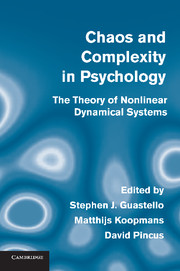Book contents
- Frontmatter
- Contents
- Contributors
- Preface
- 1 Introduction to Nonlinear Dynamics and Complexity
- 2 Collective Intelligence: Observations and Models
- 3 Neurodynamics and Electrocortical Activity
- 4 Psychophysics
- 5 Temporal and Spatial Patterns in Perceptual Behavior: Implications for Dynamical Structure
- 6 Embodied and Embedded: The Dynamics of Extracting Perceptual Visual Invariants
- 7 Origins of Order in Cognitive Activity
- 8 Nonlinear Complex Dynamical Systems in Developmental Psychology
- 9 Developmental Psychopathology: Maladaptive and Adaptive Attractors in Children's Close Relationships
- 10 Psychopathology
- 11 Coherence, Complexity, and Information Flow: Self-Organizing Processes in Psychotherapy
- 12 The Dynamics of Human Experience: Fundamentals of Dynamical Social Psychology
- 13 Group Dynamics: Adaptation, Coordination, and the Emergence of Leaders
- 14 Organizational Psychology
- 15 Complexity, Evolution, and Organizational Behavior
- 16 Agent-Based Modeling Within a Dynamic Network
- 17 Epilogue: Psychology at the Edge of Chaos
- Index
15 - Complexity, Evolution, and Organizational Behavior
Published online by Cambridge University Press: 18 December 2013
- Frontmatter
- Contents
- Contributors
- Preface
- 1 Introduction to Nonlinear Dynamics and Complexity
- 2 Collective Intelligence: Observations and Models
- 3 Neurodynamics and Electrocortical Activity
- 4 Psychophysics
- 5 Temporal and Spatial Patterns in Perceptual Behavior: Implications for Dynamical Structure
- 6 Embodied and Embedded: The Dynamics of Extracting Perceptual Visual Invariants
- 7 Origins of Order in Cognitive Activity
- 8 Nonlinear Complex Dynamical Systems in Developmental Psychology
- 9 Developmental Psychopathology: Maladaptive and Adaptive Attractors in Children's Close Relationships
- 10 Psychopathology
- 11 Coherence, Complexity, and Information Flow: Self-Organizing Processes in Psychotherapy
- 12 The Dynamics of Human Experience: Fundamentals of Dynamical Social Psychology
- 13 Group Dynamics: Adaptation, Coordination, and the Emergence of Leaders
- 14 Organizational Psychology
- 15 Complexity, Evolution, and Organizational Behavior
- 16 Agent-Based Modeling Within a Dynamic Network
- 17 Epilogue: Psychology at the Edge of Chaos
- Index
Summary
Introduction
The many approaches and ideas that have been developed in exploring the relationship between complexity and organizational behavior have been reviewed recently by Maguire, McKelvey, Mirabeau, and Oztas (2006), in the Handbook of Organizational Studies. I do not attempt to summarize this wide-ranging review but instead try to put forward a personal view of the way that complexity allows us to understand evolutionary processes and, in particular, the emergence and characteristics of organizations. This is because organizations are the result of evolutionary processes, shaped by history and playing some role within a larger system. Their current structure and form are something that has emerged as the result of the particular historical processes that have been involved and of course, this evolution is still ongoing and will lead to further transformations as the complex system adapts and changes to its changing context.
The context of an organization is, of course, its physical, economic, and technological environment, as well as other organizations, individuals, and the cultural and social realities of the moment. As Tsoukas and Chia (2002) said, “Firstly, organization is the attempt to order the intrinsic flux of human action, to channel it towards certain ends by generalizing and institutionalizing particular cognitive representations. Secondly, organization is a pattern that is constituted, shaped, and emerging from change” (p. 567).
- Type
- Chapter
- Information
- Chaos and Complexity in PsychologyThe Theory of Nonlinear Dynamical Systems, pp. 452 - 474Publisher: Cambridge University PressPrint publication year: 2008
- 1
- Cited by



